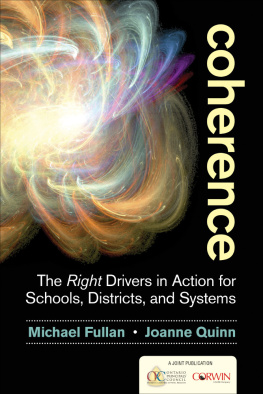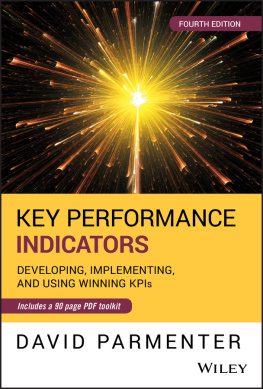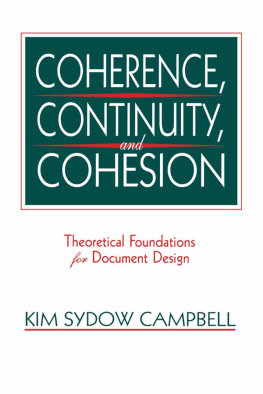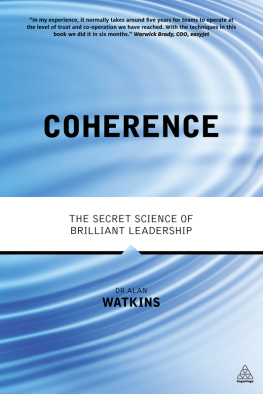Parmenter - Neo-Coherence Therapy
Here you can read online Parmenter - Neo-Coherence Therapy full text of the book (entire story) in english for free. Download pdf and epub, get meaning, cover and reviews about this ebook. year: 2013, publisher: Wipf and Stock Publishers, genre: Religion. Description of the work, (preface) as well as reviews are available. Best literature library LitArk.com created for fans of good reading and offers a wide selection of genres:
Romance novel
Science fiction
Adventure
Detective
Science
History
Home and family
Prose
Art
Politics
Computer
Non-fiction
Religion
Business
Children
Humor
Choose a favorite category and find really read worthwhile books. Enjoy immersion in the world of imagination, feel the emotions of the characters or learn something new for yourself, make an fascinating discovery.

Neo-Coherence Therapy: summary, description and annotation
We offer to read an annotation, description, summary or preface (depends on what the author of the book "Neo-Coherence Therapy" wrote himself). If you haven't found the necessary information about the book — write in the comments, we will try to find it.
Neo-Coherence Therapy — read online for free the complete book (whole text) full work
Below is the text of the book, divided by pages. System saving the place of the last page read, allows you to conveniently read the book "Neo-Coherence Therapy" online for free, without having to search again every time where you left off. Put a bookmark, and you can go to the page where you finished reading at any time.
Font size:
Interval:
Bookmark:
A Bridge to the Soul
Bruce Parmenter

Neo-Coherence Therapy
A Bridge to the Soul
Copyright 2013 Bruce Parmenter. All rights reserved. Except for brief quotations in critical publications or reviews, no part of this book may be reproduced in any manner without prior written permission from the publisher. Write: Permissions, Wipf and Stock Publishers, 199 W. 8th Ave., Suite 3, Eugene, OR 97401.
Resource Publications
An Imprint of Wipf and Stock Publishers
199 W. 8th Ave., Suite 3
Eugene, OR 97401
www.wipfandstock.com
ISBN 13: 978-1-62032-461-5
EISBN 13: 978-1-4982-7118-9
Manufactured in the U.S.A.
All scripture quotations in the text, unless otherwise indicated, are taken from the New Revised Standard Version Bible, copyright 1989, Division of Christian Education of the National Council of the Churches of Christ in the United States of America. Used by permission. All rights reserved.
All scripture quotations in the Appendix, unless otherwise indicated, are taken from the Holy Bible, New International Version, NIV. Copyright 1973, 1978, 1984, 2011 by Biblica, Inc. Used by permission of Zondervan. All rights reserved worldwide. www.zondervan.com The NIV and New International Version are trademarks registered in the United States Patent and Trademark Office by Biblica, Inc.
Permission to quote from Depth Oriented Brief Therapy has been obtained from John Wiley and Sons.
To my wife Judy and our children, Linda, Cindi, Patti, Todd, and Eric, and with special mention and gratitude to Cindi for sharing her personal experience of Coherence Therapy.
Always love to all,
Dad
The glory of God is a human being fully alive.
Irenaeus (ca. 180 ad)
B ru ce Ecker and Laurel Hulley are the authors of Coherence Therapy, set forth in their 1996 book, Depth Oriented Brief Therapy . Neo-Coherence Therapy is an interpretation and exposition of the psychotherapeutic concepts in Depth Oriented Brief Therapy . Neo signals adaptations of Coherence Therapy to my own worldview and practice modalities. Ecker and Hulley bear no responsibility for these adaptations. Permission to quote from Depth Oriented Brief Therapy has been obtained from John Wiley and Sons.
Skilled artist Kristina T. C. Panizzi Woodley, MAE, Program Director, Undergraduate Medical Education, UAB Department of Medical Education, Birmingham, Alabama, has transformed my primitive figures into images much less offensive to the eye.
Deb Siltman has rescued my handwritten pages by use of an instrument called a computer, and Lori G. Thomas has done the copyediting.
Special thanks go to my colleague, Brenda Sommer, MAC, LPC, who was my dialogue partner in clarifying our understanding of Coherence Therapy. Many months of discussions of Coherence Therapy and Neo-Coherence Therapy in relation to the wide range of problems drawn from Brendas counseling practice provided one of the best learning experiences of my life.
Special thanks also to Megan Kegerrief, former supervisee, who first called my attention to Coherence Therapy.
B ruce Ecker and Laurel Hulleys book, Depth Oriented Brief Therapy (DOBT), published by Jossey-Bass in 1996, is among the most thought-provoking books on psychotherapy I have read in my lifetime (and I have read a few, starting in 1953 with Leslie Weatherheads Psychology, Religion, and Healing, and continuing through a career of pastoral ministry, practice and teaching in pastoral counseling, university teaching in marriage and family therapy, and, in my seventy-ninth year, I am still active in clinical supervision of Masters degree students at Lincoln Christian University). Reading in the literature of psychotherapy has been my vocation and avocation through all these years.
Ecker and Hulleys work comes nearly fifty years since I first became interested in counseling, but it does not come too late. It comes in time to provide a perspective which rekindles my hope for what psychotherapy might achieve (not that I had lost faith in the efficacy of psychotherapynow I see a more elegant, effective, and economical way to bring relief to clients).
Ecker and Hulley take me back to my roots, to my first encounter with the power of the subconscious. The aforementioned work by Weatherhead (his PhD thesis at the University of London) contained the case history of a woman with the symptom of an undiagnosed body rash. When no physiological cause could be discovered, she was referred for counseling. She finally rediscovered her uneasy conscienceshe had been unfaithful to her husband while he served abroad in the British army in World War II. The affair had occurred in a certain automobile. When she would go out to shop, she would sometimes see that make of car. Each time, she would break out in a rash. She never had the symptom unless she saw the automobile. These dynamics did not emerge from the clients unconsciousness until she got in touch with her emotional truth.
Ecker and Hulley would see this sixty-year-old case history as illustrating why a symptom is necessary to have. It was necessary in order to protect the clients conscious self from the pain in the unconscious self. The symptom was a bridge to the soul, a signal that the soul was not well. The repressed inner conflict was the clients emotional truth, which, when brought to consciousness, relieved the symptom.
Symptom relief is a worthy goal in and for itself. Pain brings the client into therapy, and relief is the good end for which the client pays the therapist. In this essential business contract, a visit to your psychotherapist is no different than a visit to your dentist. You pay for pain relief, and the psychotherapist is ethically and professionally bound to try to heal or comfort.
The client in Weatherheads account went deep into her soul in terms of uncovering her emotional truth, but full relief of the psychosomatic symptom required confession and absolution (the communication to the client that her sin was forgiventhe revivifying and re-experiencing of ancient healing wordsNeither do I condemn you, go and sin no moreJohn 8:11).
Ecker and Hulley prefer now to call their therapy Coherence Therapy. They presuppose that the symptom makes sense, that it is purposive. But the purpose of the conscious symptom lies hidden in the unconscious. They believe the unconscious can be accessed quickly. Whether Weatherhead entered the unconscious quickly or slowly, I do not know, but he did, in fact, enter a domain of personality which is real in all of us. Weatherhead took his client out of the net which was hidden for her (Ps 31:4). Coherence therapy probes for that hidden net.
Weatherheads account gave me, at age twenty-two, my first awareness of the unconscious. Over the years of my counseling work, I have stumbled on the unconscious inadvertently, and occasionally attempted to break into this secret place, but for the first time, Ecker and Hulley have shown me a way to construct a regular and reliable healing path to the unconscious.
As I read Ecker and Hulley, I became more aware of my own unconscious dynamics. The reading took me back to the dramatic and traumatic events of my childhood. A month before my sixth birthday, my ten-year-old brother, George Henry, died instantly by electrocution. He and his neighbor pals had a tree house in the large maple tree in the corner lawn of our family home. George climbed higher and higher until he brushed against a power line running through the uppermost branches of the tree. Neighbors heard an explosion and saw blue flames shoot out of the top of the tree. Georges lifeless body dropped some thirty feet to the ground. His pals called for my mother, who came from the house, sent my sister Elinor (age 17) in the house for a blanket, and then called the local funeral home for C.R. Cook, the mortician. My father, the town physician and a gun hobbyist, was somewhere in the country target shooting. Someone was sent to find him.
Font size:
Interval:
Bookmark:
Similar books «Neo-Coherence Therapy»
Look at similar books to Neo-Coherence Therapy. We have selected literature similar in name and meaning in the hope of providing readers with more options to find new, interesting, not yet read works.
Discussion, reviews of the book Neo-Coherence Therapy and just readers' own opinions. Leave your comments, write what you think about the work, its meaning or the main characters. Specify what exactly you liked and what you didn't like, and why you think so.










